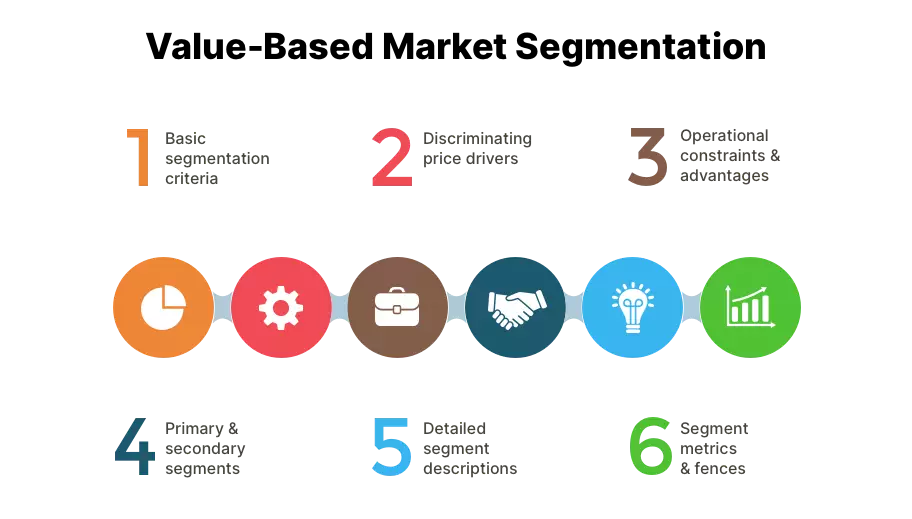Market segmentation is one of the most important tasks in marketing. Particular attention should be paid to value-based market segmentation. Identifying subgroups in a market guides marketing and sales decision-making and thereby makes the marketing and pricing process much more effective. For example, customers who are price insensitive, costly to serve, and poorly served by competitors can be charged more than customers who are price sensitive, less costly to serve, and are served well by competitors. Often, however, market segmentation focuses on customer attributes that are not really useful for pricing decisions. Value-based market segmentation helps to identify meaningful subgroups, which supports decision making.
Market Segmentation Schemes & Benefits of Value-Based Market Segmentation
There are various market segmentation modeling schemes. Often those plans emphasize the obvious, such as statistical differences in personal demographics or company firmographics (e.g. customer size, standard industrial classification, etc.). Although this segmentation approach is rather straightforward and seems quite precise, those segmentations seldom assist pricing decisions, especially for setting different prices that maximize profit from different segments. More useful are value-based market segmentation models that are based on actual value perceived and delivered to customers. Only then can a marketer ensure that each different customer subgroup is paying the most profitable price that the marketer can charge.
The differences between value-based market segmentation and other methods are especially critical for pricing. First, most segmentation criteria correlate poorly with the different motivations of different buyer groups to pay higher or lower prices. Second, even needs-based segmentations give priority only to those differences that are important to the customer. They miss the other half of the story, those customer needs that have the greatest operational impact on the seller’s costs to serve those needs. The seller’s costs and constraints are also important to pricing decisions, because the overall aim is not just sales and market share, but profitability. Finally, the customer in-depth interviews required for value-based market segmentation also uncover why customers find certain product benefits appealing. Such knowledge obviously reveals opportunities to develop new products and services.
How to conduct Value-based Market Segmentation
To conduct a value-based market segmentation, a six-step process should be applied.

Step 1: Determine Basic Segmentation Criteria
The goal of any market segmentation is dividing a market into subgroups whose members have common criteria that differentiate their buying behaviors.
Choosing these segmentation criteria starts with a descriptive profile of the total market to identify obvious segments and differences among them. In consumer markets, basic demographics of age, gender, and income provide obvious discriminators. Enterprise firmographics such as revenue, industry, and number of employees clearly separate firms into nominally homogenous groups. Inputs for this basic analysis can include existing segmentation studies, industry databases, government statistics, and other secondary sources. Outputs include buying patterns, customer descriptions, a preliminary set of current customer needs, and a provisional list of unmet customer needs.
Step 2: Identify Discriminating Value Drivers
Having preliminary segmentations in hand, you then identify value drivers. Value drivers mean nothing else than the purchase motivators that vary the most among segments but which have more or less homogenous levels within segments. This allows you to zero in on what’s most important to each customer segment. Never assume for pricing purposes that preliminary segmentations based on obvious criteria will coincidentally yield effective discrimination on value criteria.
In-depth interviews probing how and why buyers choose among competitive suppliers provide the additional input required. Industry experts, distributors, and salespeople can provide supplemental information for double checking the value perception patterns revealed by the interviews. The outputs of this step include a number of critical building blocks for value-based market segmentation, including a list of value drivers ranked by their ability to discriminate among customers, along with an explanation of why each driver adds value, and whether customers in each segment recognize that value.
Step 3: Determine Operational Constraints and Advantages
In this step, you examine where you have operational advantages. Which value drivers can you deliver more efficiently and at lower cost than others? Also, which drivers are constrained by your resources and operations? Inputs to this step can be for instance experience, capital spending plans, personnel capabilities, and overall company strategy.
With these data, you can cross-reference and compare lists of customer needs served and unserved, the seller’s advantages and resource limitations, and competitors’ abilities. Where do you have sustainable competitive advantages, and where are rivals in a better position? Which customers can you, therefore, better serve than can competitors, and which are likely to be beyond your reach?
Step 4: Create Primary and Secondary Segments
This step combines what you’ve learned so far about how customer values differ and about your costs and constraints in serving different customers. Most firms will find it convenient to segment your marketplace in multiple stages. The number of stages depends on the number of critical value drivers that create substantial differences in value delivery among customer groups. In theory, your primary segmentation is based on the most important criterion differentiating your customers. Your secondary segmentation divides primary segments into distinct subgroups according to your second most important criterion, and so on.
In practice, however, the deeper your successive segmentations, the more unmanageable the number of segments you identify. Minor differences among subsegments will have little impact on pricing policies. Therefore, focusing on primary and secondary segments should be sufficient for most firms.
Step 5: Create Detailed Segment Descriptions
Value-based market segmentation variables can look meaningful to the price strategist, but segments should be described in everyday business terms so that salespeople and marketing communications planners know what kinds of customers each segment represents.
Step 6: Develop Segment Metrics and Fences
This is the next logical step in pricing strategy and management. In this final step, it is important to recognize that segmentation is not useful until you develop the metrics of value delivery to market segments and devise fences that encourage customers to accept price policies for their segments. Metrics are the basis for tracking the value customers receive and how they pay for it. Fences are policies, rules, programs, and structures that customers must follow to qualify for price discounts or rewards.
Firms should choose metrics and fences that help to enforce premium prices for high value segments, and allow feature repackaging and unbundling to appeal to low-value and low-cost-to-serve segments. The result should be a menu of prices, products, services, and bundles that reflect different value received for different prices paid.








